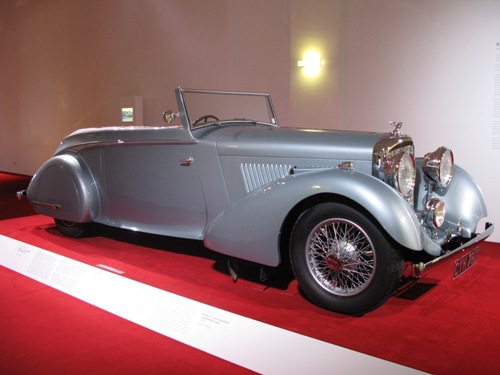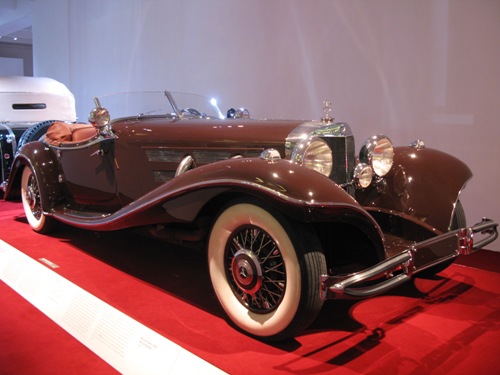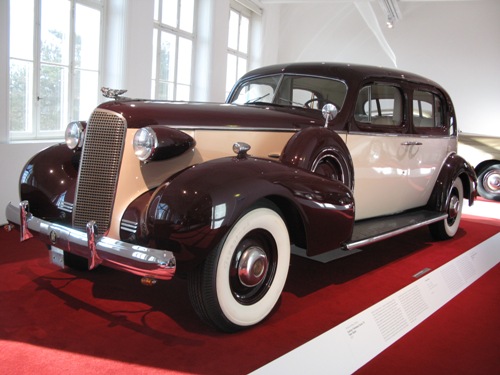
Bentley 4 ¼ Litre streamlined-doubleheaded-coupé
1936
Woolf "Babe" Barnato is the only Le Mans racing driver to have a perfect wins-to-starts ratio. The "Bentley Boy" won each of the three 24 Hours races he entered: in 1928, with Bernard Rubin on a Bentley 4.25-Litre; in 1929, with Henry Tim Birkin on a Bentley Speed Six; and in 1930 with Glen Kidston again on a Speed Six. But Barnato was just not a successful racing driver for Bentley Motors Ltd., which was founded 1919. Already in the early 1920s, Barnato, who had inherited a multi-million pound fortune, invested heavily in the company, and in 1925 he became its majority shareholder and chairman. The company, based in Cricklewood in North London, was severely affected by the Stock Market Crash: in 1931 was forced to sell to its arch-rival in the luxury car segment, Rolls-Royce, which thus complemented its own reputation reliability with the sporting image earned by the Le Mans winners. With production of the Bentley now relocated to Derby, the first model to be developed there was the 3.5-Litre, which became known as the "silent sports car"; 1177 cars of this type were built. In order to guarantee higher sustained speeds, a 4.15-Litre version of the car was built a few years later using the same chassis, of which a total of 1,234 left the assembly line at Derby until 1939. The Barnatos drove both cars. A 3.5-Litre car registered in the name of Mrs Woolf Barnato in 1935 was equipped with a made-to-order body commissioned from Mulliner. It was re-fitted to this 4.25-Litre Bentley one year later by Mr Woolf Barnato, who had remained true to “his” make despite the change in ownership.

Mercedes-Benz 500K
Special Roadster
1936
Mercedes-Benz presented its new five-litre supercharged vehicle as an "autobahn courier" at the International Automobile and Motorcycle Exhibition in Berlin in March 1934. This "utility vehicle" became the Exhibition's talking point and completely eclipsed the Type 380 showcased in four body variants. After years of global crisis, the paying public was once again showing an appetite fore more powerful models. The company responded quickly. Only three months later, orders could be placed for the "Type 500 with supercharger" in seven variants, for around 22,000 Reichsmark, almost six and a half times the cost of a standard-size automobile. In autumn of that year, the first variant of the Special Roadster, available at an extra charge of 4,000 Reichsmark, made it delivered at the Paris Salon. Exactly one year later, in October 1935, Mercedes-Benz presented a new, entrancingly beautiful version of the Special Roadster at that same event; with a price tag of 28,000 Reichsmark, it was to remain the most expensive variant of the 500K. With it and its successor, the evolved 540K engine, the Stuttgart-based motor company succeeded impressively not only in designing a top-class vehicle which was in demand worldwide, but also in living up to its reputation as an automobile manufacturer of the highest quality, pioneering technology, and elegant and sporting design – an image to which this luxury roadster with its long 3.3 m wheelbase truly does justice.

Cadillac Fleetwood Series 75
Town Sedan
1937
Cadillac, Chevrolet, Pontiac – some of the most prestigious US car makes have French names. Detroit, the hub of today's automobile industry in the US (French for straits, sound), was originally a French settlement. It was founded by Antoine Laumet de La Mothe, Sieur de Cadillac; 200 years later, in August 1902, a company by the same name began to manufacture automobiles in Detroit. The exquisite charm of the French name seemed ideally suited for marketing a luxury product, especially since Cadillac with its innovative engineering and perfect craftsmanship was indeed in a class of its own. In the States especially, where the automobile served to mobilize the masses, it was a delight to stand out from those very masses.
And in the land of the automobile the car was well suited as a means of displaying wealth and lifestyle in public. It had to be large so it would not be overlooked, but also discreet and quite; but above all, it had to be tall. Most passengers wore hats, and they did not care to have to bow when getting into or out of the car, especially if people were looking on. The Cadillac Fleetwood Series 75 satisfied all these criteria. With its elongated wheelbase and extended roof super-structure, this Fleetwood version was initially designed as a representative vehicle and a diplomat's automobile. First produced in 1936, its basic concept lasted well into the 1980s. The Cadillac Fleetwood Town Sedan was a very rare version in the US, and all the more so in Europe, where the marque was only ever able to occupy a niche position.
